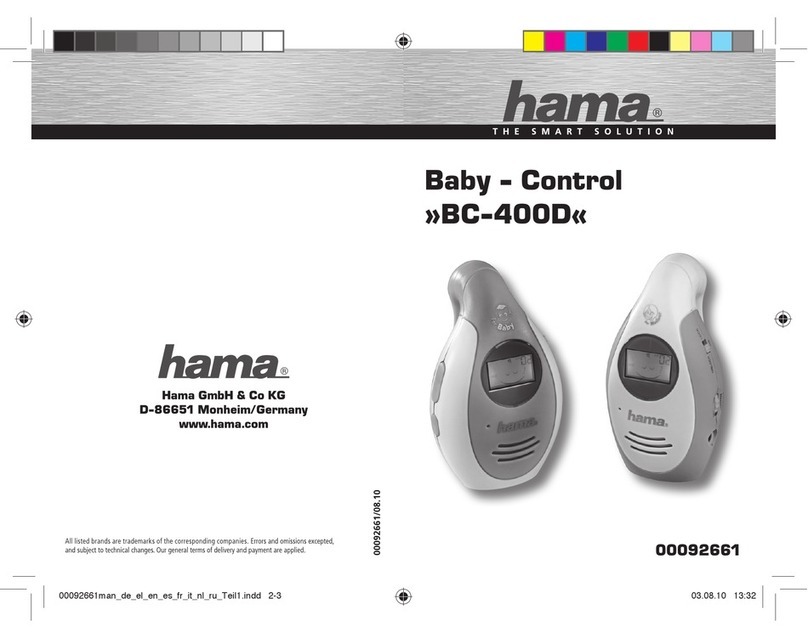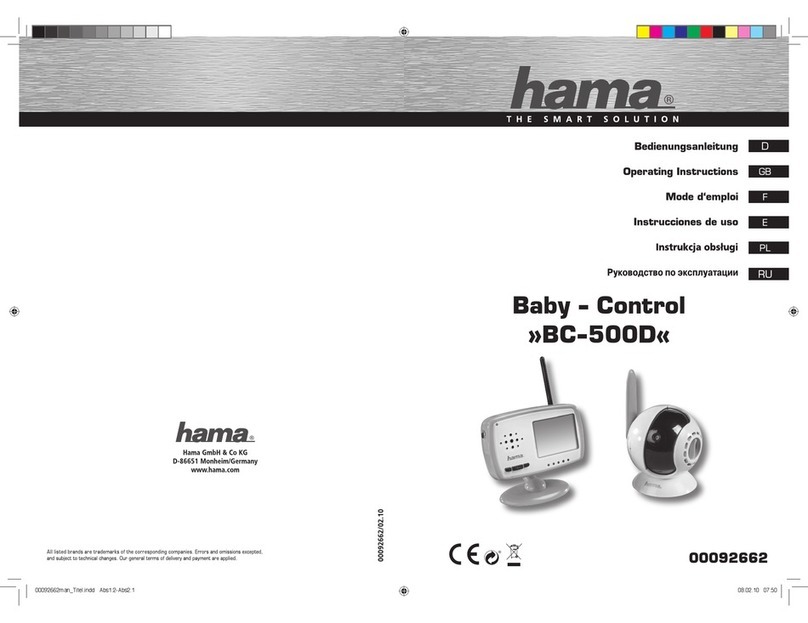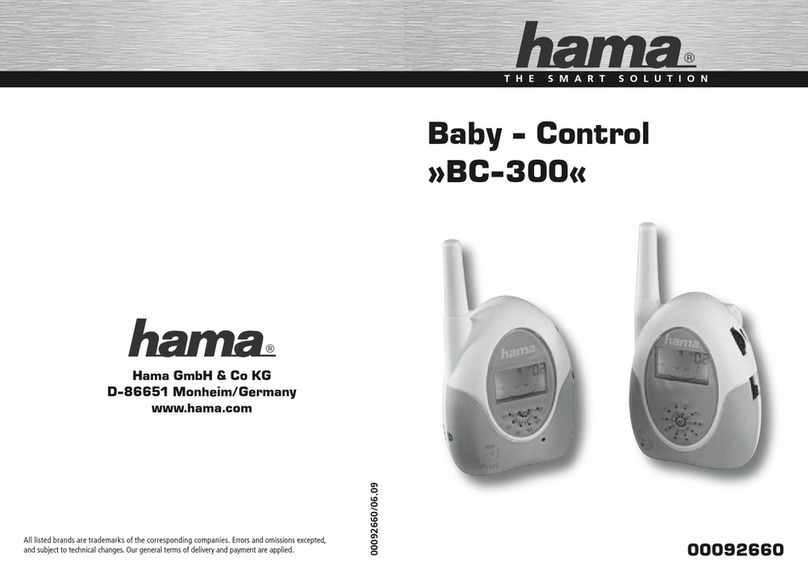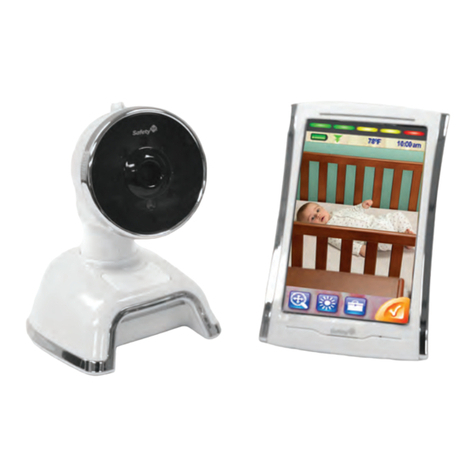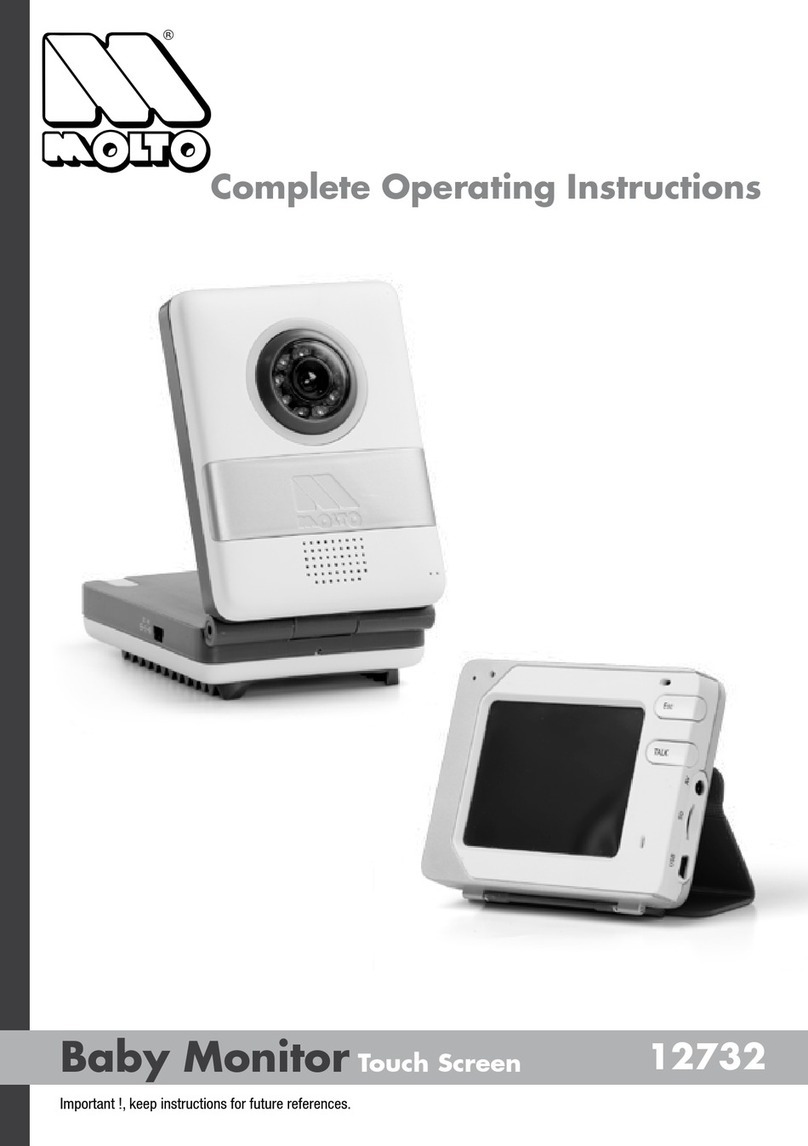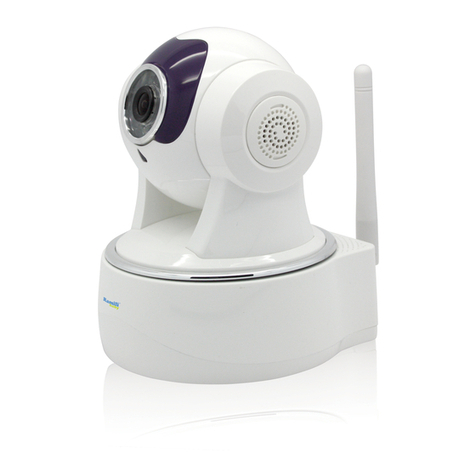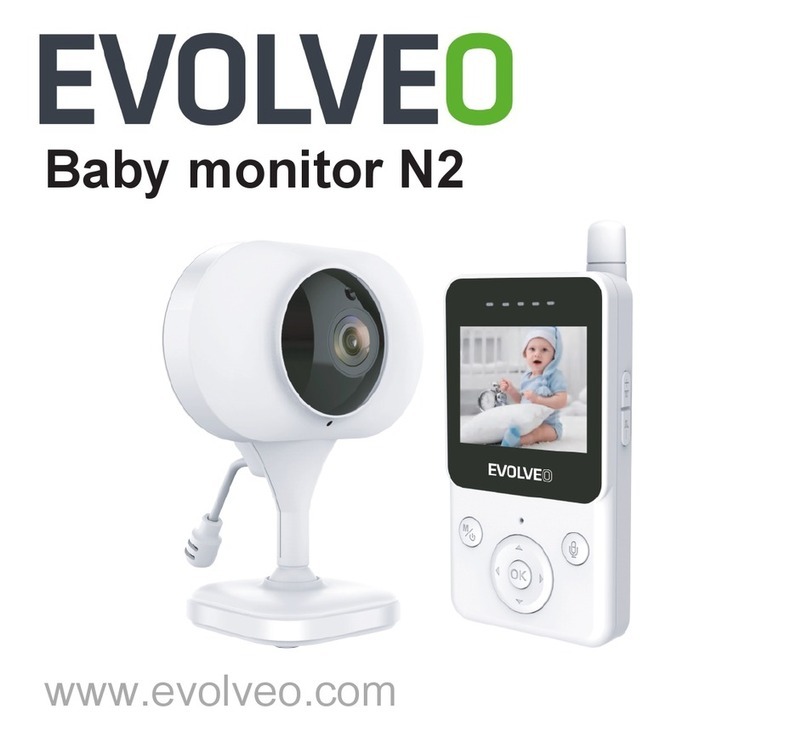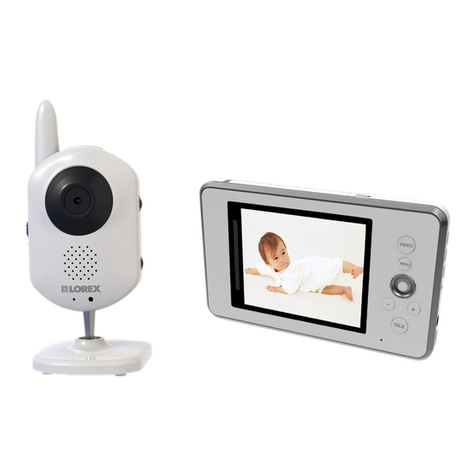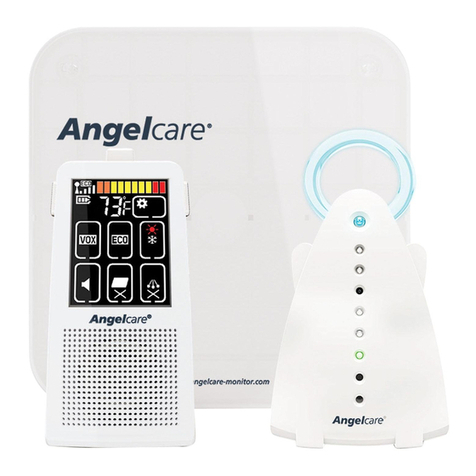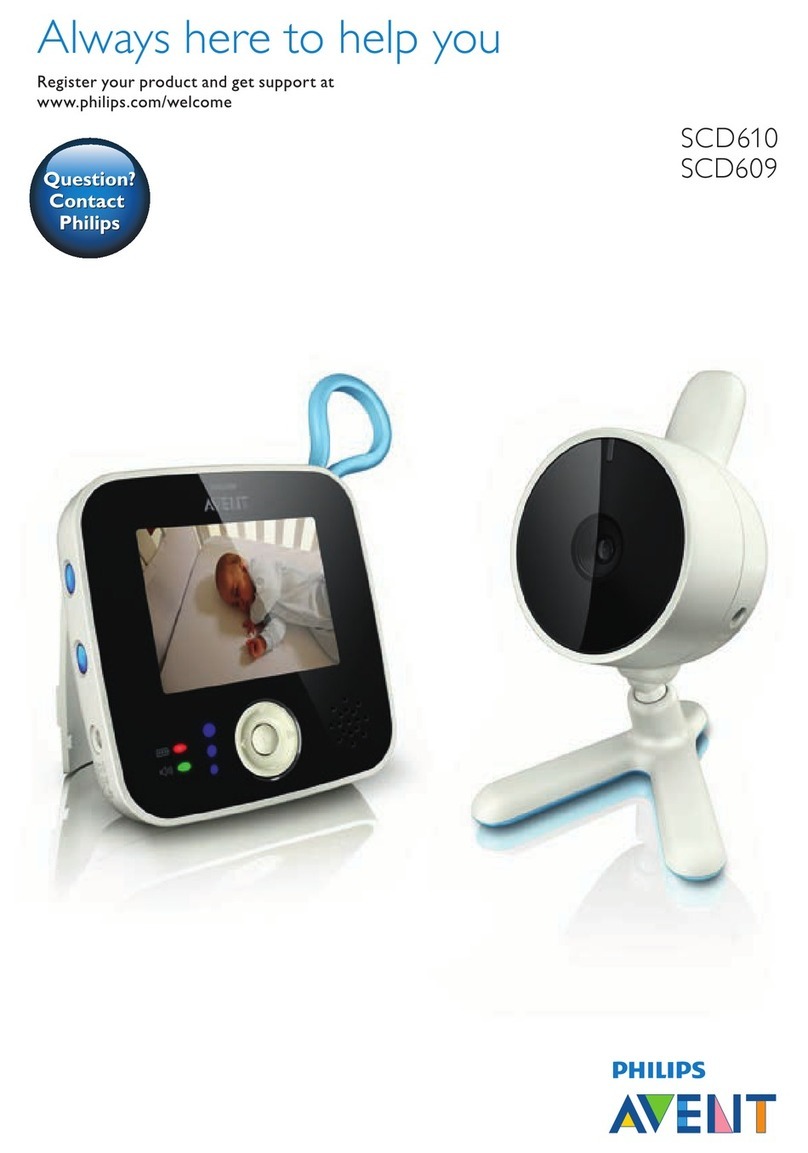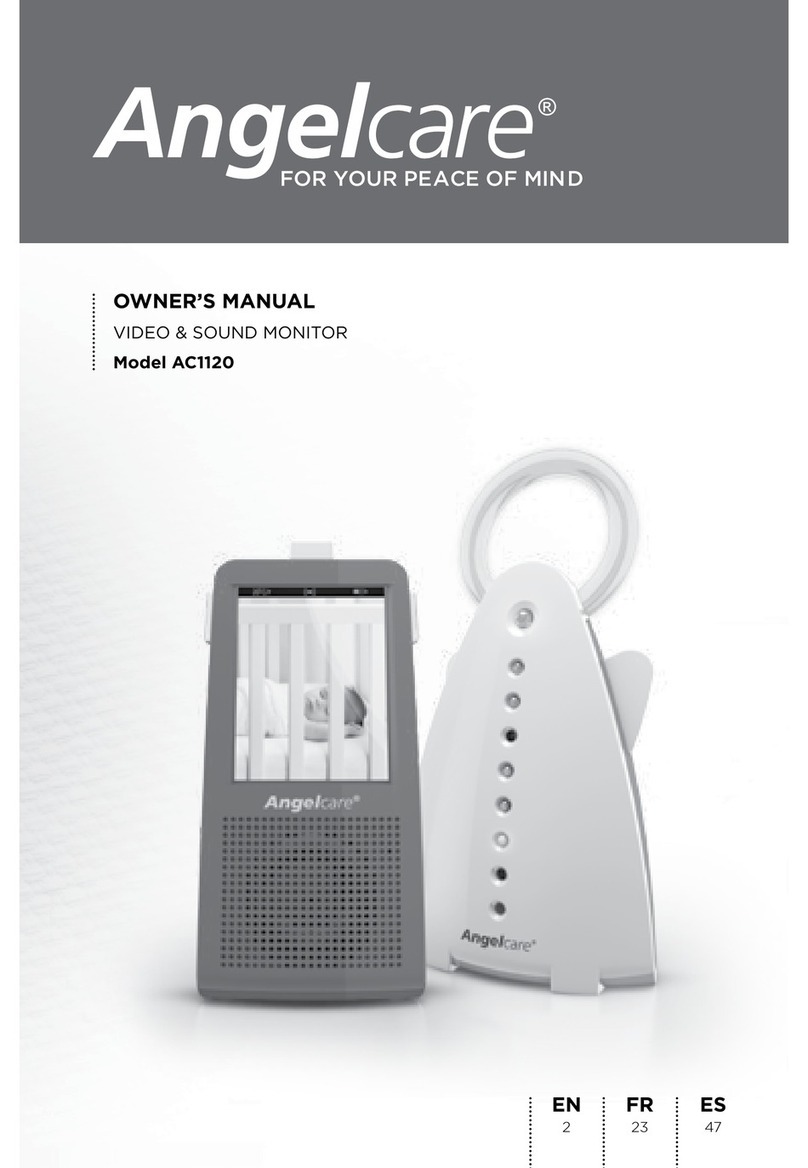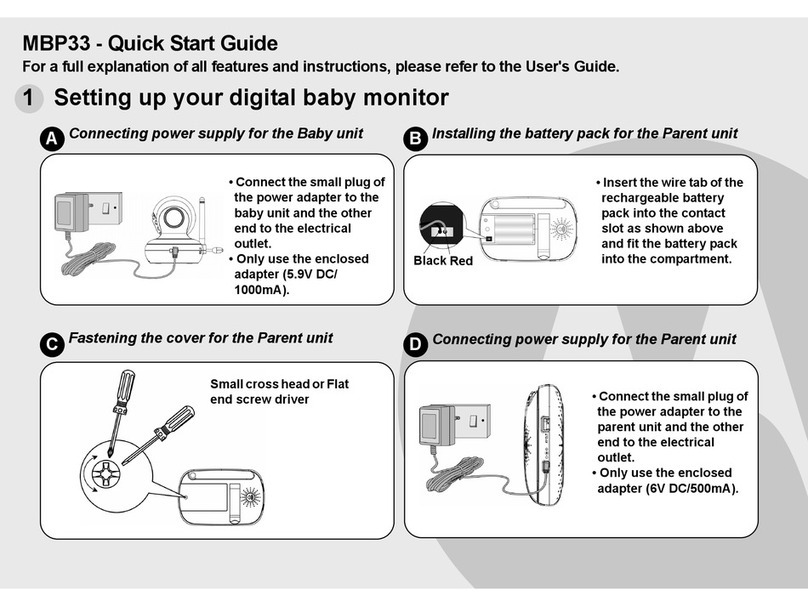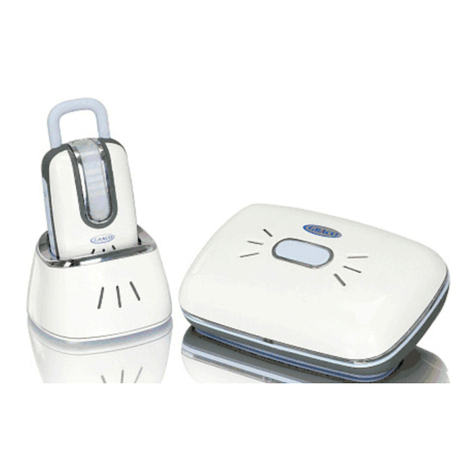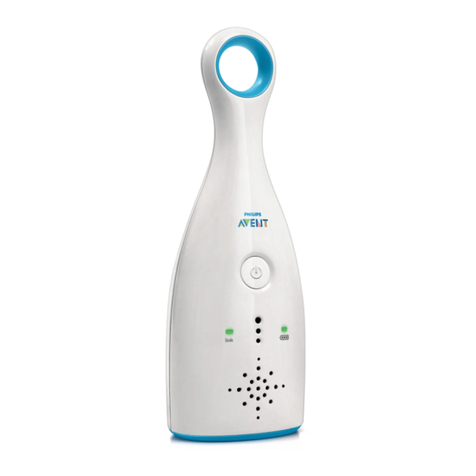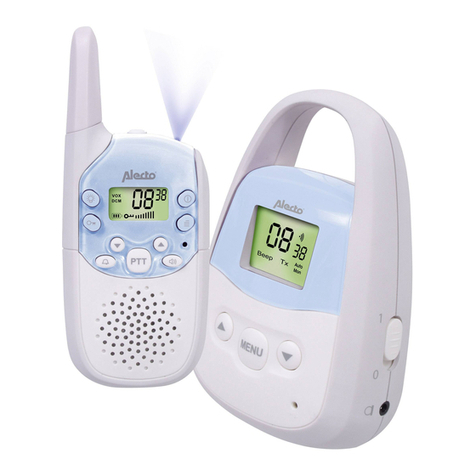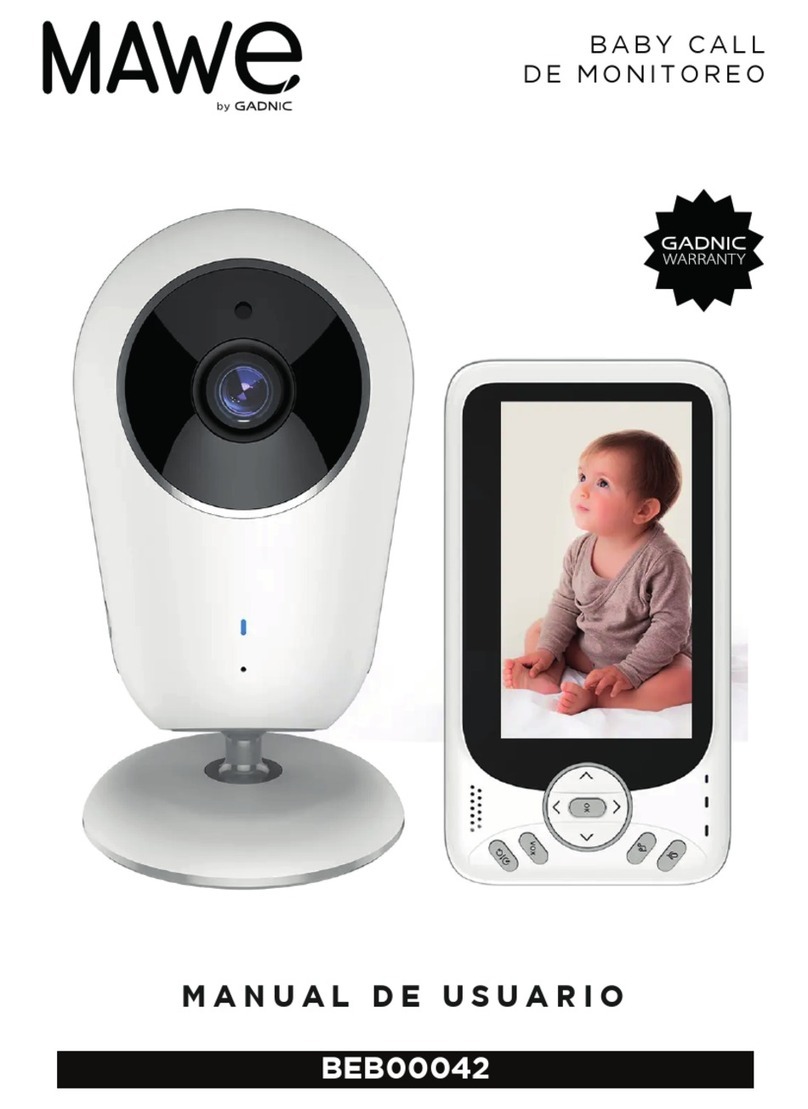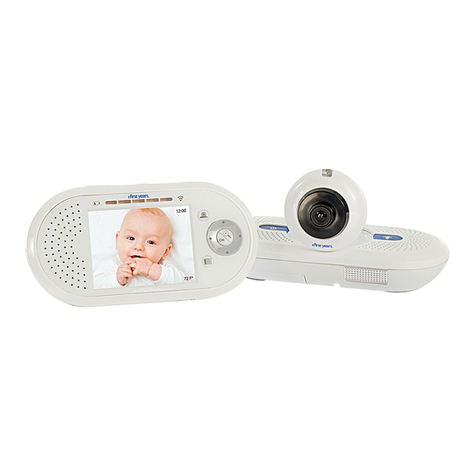Hama Baby Control BC-439 User manual

Using AC Power
1. Plug one end of the provided power adapter into awall outlet and the
other end into the rear of the monitor. See Fig. 10.
Note: Use the adapter labeled OUTPUT: 6VDC with the monitor.
2. Turn themonitor on. The channel1 indicatorand powerindicator
LEDs should light up. Set the same channel as camera by pressing the
CH button. See Fig 10.
3. Adjust the volumeto a comfortablelevel.
Other Applications
Recording on a VCR
1. The monitor comeswith anAV (audio/video) output jack forconnecting to a
VCR for recording.
2. Connect the mini plug of the provided AV cable to the AV jack on the rear of
the monitor. Connect then the other end of the cable to the AV jacks (or Scart
connector) of the AV componentlabeled LINEOUT. See Fig 11.
Voice-activated function (Auto mode)
This voice-activated modeallows you toset the sensitivity of audio levelthat
will trigger the monitor. To use voice-activated function, follow thesesteps:
1. Set the sensitivity control on the monitor to the level you prefer. See Fig.
Note: The sensitivitylevel can varybetween 0 and 9. Avalue of 0gives
minimum sensitivity avalue of 9gives maximum sensitivity.
2.
See Fig 12.
3.
Troubleshooting
If youare not getting any signal at all
Make sure the camera and the monitor are turned on.
Make sure the power plugs are pushed all the way in.
Check that the channel switches on the camera and the monitor are set to the
same number.
If the camera/monitoris powered bybatteries, replace all batteries with new
ones.
If the signal is poor, or there is interference
Check that the channel switches on the camera and the monitor are set to the
same number.
If there is amicrowave oven in use in the path between the camera and
monitor, removethe microwaveoven orturn itoff.
Make sure the camera and the monitor are within range of each other (range
of approximately 300 feet; 100 meters in aclear line of sight).
Care and Maintenance
Keep all parts and accessories out of young children's reach.
Fingerprints or dirt on the lens surface can adversely affect camera
performances. Avoid touching the lens surface with your fingers.
Should the lensbecome dirty, use ablower to blowoff dirt and dust, ora soft,
dry cloth to wipe off the lens.
Keep the cameradry.Precipitation, humidity, and otherliquids contain
minerals that willcorrode electronic circuits.
Do not useor store industy, dirty areas.
Do not storein hot areas.High temperatures can shorten the lifeof electronic
devices and warpor melt certainplastics.
Do not storein very coldareas. When the system warmsup (to its normal
temperature), moisture can form inside the case, which may damage
electronic circuit boards.
Do not attemptto open thecase. Non-expert handling of the devicemay
damage the system.
Avoid dropping or strong shocks.
Operate this productusing only withthe power supply included or provided
as an accessory.
Do not overload electrical outlets or extension cords this can result in fire or
electric shocks.
Do remember thatyou are usingpublic airwaves when you use thesystem
and that sound and video may be broadcast to other 2.4 GHz receiving
devices. Conversations, evenfrom rooms nearthe camera, may be broadcast.
To protect the privacyof your home, always turn thecamera off when not in
use.
Specifications
Press theAuto button on the front ofthe monitor. This will turn off the screen
but the power LED will still be on.
When the sound from the camera reaches the set level, the screen will turn on
automatically. It will turn offagain after30 seconds.
Note: Under/In voice-activated mode,the monitor canonly detect signal
input from onecamera at atime. The CH button isnot functional under
Vo ice-activated mode.
If the power LED is on but onlyvoice signal input isdetected, themonitor
can be in voice-activated mode. Press the Auto button to turn on the screen.
4. Allumez le moniteur. Les voyantsdu canal 1et d'alimentation devrait
s'allumer. Définissez le mêmecanal que surla caméra en pressant le
bouton CH. Voir la fig. 9.
5. Ajustez le volumeà un niveauconfortable.
Utiliser l'alimentationCA
1. Branchez une extrémité de l'adaptateur d'alimentation fourni dans une
prise murale et l'autre extrémité au moniteur. Vo ir la fig. 10.
Note: Utilisez l'adaptateur étiquetéOUTPUT: 6VCC avec le
moniteur.
2.
Voir lafig. 10.
3.
.
Autres applications
Enregistrer sur un magnétoscope
1. Le moniteur estéquipé d'une prisede sortie AV (audio/vidéo) pour connecter
à un magnétoscopepour enregistrer.
2. Connectez la mini fiche du câble AV fourni à la prise AV àl'arrière du
moniteur. Connectez alors l'autre extrémité du câble aux prises AV (ou
connecteur Scart) du composant AV étiquetéLINE OUT. Vo ir la fig. 11.
Fonction d'activationvocale (Mode Auto)
Le mode d'activation vocale permet de définir la sensibilité du niveau audio qui
déclenchera le moniteur. Pour utiliserla transmission vocale, suivez ces étapes:
1. Réglez le contrôlede sensibilité dumoniteur au niveauque vous préférez.
Voir la fig. 12.
Note: Le niveau desensibilité peut varierentre 0 (sensibilitéminimum) et 9
(sensibilité maximum).
2. Pressez le boutonAUTOau devant du moniteur.Le moniteur s'éteindra. Vo ir
la fig.
3. Quand le son de la caméra atteint le niveau défini, le moniteur s'allumera
automatiquement. Il s'éteindraaprès 1 minuted'inactivité.
Dépannage
Si vousne recevezpas de signal du tout
Assurez-vous que lacaméra et lemoniteur sont allumés.
Assurez-vous que lesprises de courantsont bien branchées.
Vérifiez que les commutateursde canaux de la caméra et du moniteur sont
définis au même numéro.
Si la caméra/ lemoniteur sont alimentéspar piles, remplaceztoutes les piles
avec des pilesneuves.
Si lesignal estfaible, ou il ya desinterférences
Vérifiez que les commutateurs de canaux de la caméra et du moniteur sont
définis au même numéro.
Si un fourà micro-ondes encours d'utilisation se trouve entre lacaméra et le
moniteur, retirez-leou éteignez-le.
Assurez-vous que la caméra et le moniteur ne sont pas trop éloignés l'un de
l'autre (approximativement 100 mètres de portée avec ligne de vue dégagée).
Soin et entretien
Gardez tous lesaccessoires et pièceshors de la portée des enfants.
Des traces de doigts ou de la poussière sur la surface de la lentillepeuvent
affecter l'exécutionde la caméra.Evitez de toucher la surface dela lentille
avec les doigts.
Si la lentille devient sale, utilisez un souffletpour retirer la poussière, ou un
chiffon douxet sec pour essuyer la lentille.
Gardez la camérasèche. Les précipitations,l'humidité, et autresliquides
contiennent des minérauxqui corroderont lescircuits électroniques.
N'utilisez ou nestockez pas dansdes zones poussiéreuseset sales.
Ne stockez pas dans des endroits chauds. Des températures élevées peuvent
raccourcir la duréede fonction despériphériques électroniques et déformer
ou fondre certainsplastiques.
Ne stockez pas dans des endroits très froids.Quand le système se réchauffe (à
sa température normale), del'humidité peutse former,ce qui peut
endommager les cartesà circuit électroniques.
Ne tentez pas d'ouvrir le boîtier. Une mauvaise manipulationdu périphérique
peut endommager lesystème.
Evitez chutes etchocs violents.
N'opérez ce produitqu'avec l'alimentation incluseou fournie comme
accessoire.
Ne surchargez pas les sorties ou les rallonges électriques cecipeut
provoquer des incendiesou des chocsélectriques.
Souvenez-vous que vousutilisez les ondespubliques quand vous utilisez le
système et qu'audio/vidéo peuvent être diffusés àd'autres périphériques 2,4
GHz. Les conversations, même de salles proches de la caméra,peuvent être
diffusées. Pour protéger votre intimité, éteigneztoujours lacaméra quand
vous ne l'utilisezpas.
Pressez le boutonAutosur le moniteur. Ceci éteintl'écran mais le
voyant d'alimentation resteallumé.
Quand le sonde la caméraatteint le niveau défini, l'écran s'allume
automatiquement. Il s'éteintaprès 30 secondes
Note: Sous le moded'activation vocale, lemoniteur ne peut détecter
le signal d'entréeque d'une seulecaméra à la fois. Le boutonCH n'est
pas fonctionnel sousle mode d'activationvocale.
Si le voyantd'alimentation est allumémais seul le signal d'activation vocal
est détecté, lemoniteur est peutêtre en mode d'activation vocale. Pressezle
bouton Auto pour allumer l'écran.
English
What You Get
One Camera
One monitor
One A/V (audio/video) cable (mini-RCAor mini-Scart)
Two power adapters (9V DC,300mAfor Camera;6V DC,600mA for
monitor)
Mounting Plate
Fixing screws and Masonry Plugs
This User's Manual
Note: The AC adapters CANNOTbe interchanged. Use only the adapter
labeled OUTPUT:9V DCwith the camera. Use only the adapter labeled
OUTPUT: 6VDC with the monitor.
Product Layout
Monitor (Fig.1)
1. Voice sensitivity control
2. Power/Volume control
3. Auto mode (Voice-activated function)
4. Channel selection button(select the channelyou want bypressing achannel
button. )Note: You mustselect thesame channelon the camera and on the
monitor.
5. Power indicator LED
6. Channel indicator LEDs
7. Brightness adjustment button(7 levels ofbrightness control. The power
LED will blinkwhen pressing the(-) or (+) button to thehighest or lowest
level.)
8. Keyholes
9. Battery compartment
10. 6V DC Power adapterplug
11. AV output jack (mono sound)
Camera (Fig. 2)
1. Infrared LEDs
2. Lens
3. Lens head
4. Microphone
5. Keyholes
6. Battery compartment
7. Power indicator LED
8. OFF/ON/NIGHT (Power OFF/Power ON/NightVisionon)
9. Channel selection switch (select the channel by sliding the switch to the
desired channel number.) Note: Yo u must select thesame channel on the
camera and on the monitor.
10. 9V DC power adapter plug
Setting UP
Setting Up the Camera
Power Supply
The camera uses either 4 AA-Size batteries (alkaline battery
recommended) or thehouseholdAC current.
Loading the Batteries
1. Open the batterycompartment cover onthe rear of the camera. See
Fig. 3.
2. Insert 4AA-size batteries (followthe plus (+) and minus (-)signs on the
diagram inside thebattery compartment). See Fig. 3.
3. Close the batterycompartment cover,and make sure it is locked
securely.
Note 1: Never mix oldbatteries with new ones.
Note 2: Remove the batteriesfrom the cameraif you do not plan to
use it fora prolonged periodof time.
4. Slide the POWER switch tothe ONposition. The LED onthe bottom
of the camera should light up. See Fig. 3.
Using AC Power
1. Plug one end of the provided power adapter into awall outlet and the
other end into the bottom of the camera. See Fig. 4.
Note: Use the adapterlabeled OUTPUT:9V DCwith the camera.
2. Slide the ON/OFF/NIGHT switchto theON position.The LEDon the
bottom of the camera should light up. See Fig. 4.
Fine Tu ning
Place the camerain aconvenient location, point the lens towards the
observation area andadjust the angleby rotating the lens head. See Fig. 5.
Wall Mounting the Camera
Note: The monitor receptionshould be testedbefore fixing the camera in
place. Have someonehold the cameraagainst the wall in the selected
mounting area while you check the reception on the monitor. If
interferences or other problems occur, referto theTroubleshooting
section. Yo u may need to select adifferent locationin the room for
mounting the camera.
1. Drill two holes 52mm apart in a line, at the camera mounting position.
2. Fix the provided mounting plate to the wall using the masonry plugs
and fixing screws supplied. See Fig. 6.
3. Place the camera against the mounting plate so that the studs on the
mounting plate areadjusted to thekeyholes on the back of camera.
Then pull thecamera down toslide the studs into the cutoutchannels.
See Fig. 7.
Night Vision
The camera hassix high-intensity LEDsfor picking up clear images in
unlit locations.Toturn onthe nightvision function,slide theswitch on
the bottom of the camera to the NIGHT position. See Fig. 8.
Note 1: The image changes automatically into B/Wunder thenight
vision mode.
Note 2: Turn off the night vision function when not required to save
power.
Setting Up the Monitor
Power Supply
The monitor uses either 4 AA-Size batteries (alkaline battery
recommended) or thehouseholdAC current.
Loading the Batteries
1. Open the batterycompartment cover onthe rear of the monitor. See
Fig. 9.
2. Insert 4AA-size batteries (followthe plus (+) and minus (-)signs on the
diagram inside thebattery compartment). See Fig 9.
3. Close the batterycompartment cover,and make sure it is locked
securely.
Note 1: The power indicatorLED will flash to indicate theneed to
replace the batteries when the battery power is low.
Note 2: Never mix oldbatteries with new ones.
Note 3: Remove the batteriesfrom the monitorif you do not plan to
use it fora prolonged periodof time.
4. Turn the monitor on. The channel1 indicator and power indicator
LEDs should light up. Set the same channelas camera by pressingthe
CH button. See Fig 9.
5. Adjust the volumeto a comfortablelevel.
Ce que vous avez
Une caméra
Un moniteur
Un câbleA/V (audio/vidéo - mini-RCAou mini-Scart)
Deux adaptateurs d'alimentation (9VCC, 300mApour la caméra ;6V CC,
600mA pour le moniteur)
Plaque de montage
Vis de fixation etchevilles de maçonnerie
Ce manuel del'utilisateur
Note: Les adaptateurs CA ne sont pas interchangeables. N'utilisez que
l'adaptateur étiqueté OUTPUT: 9VDC avec la caméra.N'utilisez que
l'adaptateur étiqueté OUTPUT: 6VDC avec le moniteur.
Disposition du produit
Moniteur (Fig.1)
1. Contrôle de sensibilitévocale
2. Contrôle d'alimentation/volume
3. Mode Auto (fonction d'activationvocale)
4. Bouton de sélection de canaux (sélectionnez lecanal désiré en pressant un
bouton de canal. Note: Vo us devez sélectionner lemême canal sur la caméra
et sur le moniteur.)
5. Voyant d'alimentation
6. Voyants d'indicateurde canaux
7. Bouton d'ajustement deluminosité (7 niveauxde luminosité. Le voyant
d'alimentation clignotera sivous pressez lebouton (-) ou (+) au niveaule
plus élevé/bas.)
8. Trous defixation
9. Compartiment des piles
10. Fiche d'adaptateur d'alimentation CC 6V
11. Prise de sortie AV (son mono)
Caméra (Fig. 2)
1. Voyants infrarouges
2. Lentille
3. Tête de lalentille
4. Microphone
5. Trous defixation
6. Compartiment des piles
7. Voyant d'alimentation
8. Eteint/Allumé/Nuit (OFF/ON/NIGHT. Bouton Pour la Mise sous
tension/Hors tension et la Visionde Nuit.)
9. Commutateur de sélectionde canaux (sélectionnezun canal en déplaçant le
commutateur sur lenuméro du canaldésiré. Note: Vo us devez sélectionner
le même canal sur la caméra et sur le moniteur.)
10. Fiche d'adaptateur d'alimentation CC 9V
Installation
Installer la caméra
Alimentation
La caméra utilisesoit 4 pilesde taille AA (piles alcaline recommandées)
ou le courant CA normal.
Charger les piles
1. Ouvrez le compartiment des piles àl'arrière de la caméra. Vo ir la fig. 3.
2. Insérez 4 pilesAA(suivez les signes plus (+) etmoins (-) du diagramme
dans le compartimentdes piles). Vo ir la fig. 3.
3. Refermez le compartimentdes piles, etassurez-vous qu'il est bien
verrouillé.
Note 1: Ne mélangez jamaisdes piles usagées avec des pilesneuves.
Note 2: Retirez les piles de la caméra si vous n'avez pas l'intention de
l'utiliser pour une longue période de temps.
4. Glissez l'interrupteur d'alimentationsur la positionON (allumé). Le
voyant sous la caméra devrait s'allumer. Vo ir la fig. 3.
Utiliser l'alimentation CA
1. Branchez une extrémité de l'adaptateur d'alimentation fourni dans une
prise murale et l'autre extrémité dans la caméra. Vo ir la fig. 4.
Note: Utilisez l'adaptateur étiquetéOUTPUT: 9VDC avec la caméra.
2. Glissez le commutateur ON/OFF/NIGHTsur laposition ON(allumé).
Le voyant sous la caméra devrait s'allumer. Vo ir la fig. 4.
Réglages
Placez la caméra dans un emplacementadéquat, dirigez la lentille vers la
zone d'observation et ajustez l'angle en pivotant la têtede la lentille. Vo ir
la fig. 5.
Fixer la caméra au mur
Note: La réception dumoniteur devrait êtretestée avant de fixer la
caméra en place.Demandez à quelqu'unde maintenir la caméra contre le
mur dans lazone de montagesélectionnée pendant que vous contrôlez la
réception sur lemoniteur.Si des interférencesou d'autres problèmes
surviennent, consultez la section de dépannage. Vo us devrez peut-être
choisir un autreemplacement pour monterla caméra.
1. Percez deux trous séparés de 52 mm en ligne, àla position de montage
de la caméra.
2. Fixez la plaque de montage au mur en utilisant les chevilles de
maçonnerie et les vis de fixation fournies. Vo ir la fig. 6.
3. Placez la caméra contre la plaque de montage pour que les goujons sur
la plaque soientajustés aux trousde fixation au dos de lacaméra.
Faites alors glisserles goujons dansles orifices de la caméra. Vo ir la
fig. 7.
Vision nocturne
La caméra asix voyants àintensité élevée pourprendre des imagesclaires
dans des emplacements pas éclairés. Pour activer la fonction de vision
nocturne, déplacez le commutateur sous la caméra sur la position NIGHT.
Voir lafig. 8.
Note 1: L'image passe automatiquement en N/B en mode de vision
nocturne.
Note 2: Eteignez la fonctionde vision nocturne pour économiser
l'alimentation si vousne l'utilisez pas.
Installer le moniteur
Alimentation
Le moniteur utilisesoit 4 pilesde taille AA (piles alcaline recommandées)
ou le courant CA normal.
Charger les piles
1. Ouvrez le compartiment des piles àl'arrière du moniteur. Vo ir la fig. 9.
2. Insérez 4 pilesAA(suivez les signes plus (+) etmoins (-) du diagramme
dans le compartimentdes piles). Vo ir la fig. 9.
3. Refermez le compartimentdes piles, etassurez-vous qu'il est bien
verrouillé.
Note 1: Le voyant d'alimentation clignotera lorsque les piles sont
faibles et doiventêtre remplacées.
Note 2: Ne mélangez jamaisdes piles usagées avec des pilesneuves.
Note 3: Retirez les piles du moniteur si vous n'avez pas l'intention de
l'utiliser pour une longue période de temps.
Product Layout/Disposition du produit/Aspecto del producto
/Produkt-Layout/Struttura del prodotto
Monitor/Moniteur
Setting UP/Installation/Configuración/Einrichten/Installazione
Français
Figures and Quick Guide/
/
Figures et guiderapide
Figuras y Guía Rápido/Abbildungen und Schnellanleitung
/Figure e guida rapida
11
2
2
11
2
2
11
11
1
1
..
.
.
..
..
.
.
11
1
1
22
33
4
4
Power Supply/Alimentation/Suministro de corriente/Netzgerät
/Alimentazione
1
1.1
Fig. 1
Fig. 2
Fig. 3
1
1
1
.
.
.
2
3
4
Fine Tuning/ //F
/
Réglages Ajuste precisoeinabstimmung
Messa apunto
Wall Mounting the Camera/
//W
/
Fixer la caméra au mur
Instalación de la cámara en la pared andmontage der Kamera
Montaggio a parete della videocamera
Night Vision/ //N
/
Vision nocturneVisión nocturna achtsicht
Visualizzazione notturna
Specifications subject tochange without notice
Monitor
Frequency 2.4 GHz
Channel 3 selectable channels
A/V mod/demod. method FM
Antenna Built-in omni-directional antenna
Display 1.5" LTPS-TFT LCD
Display colors Full-color
Dimensions 8.5(W) x 14(H) x 5.3(D) cm
(3.3 x 5.5 x 2.1 inches)
Weight 240g (8.52 ounces)
Power DC 6V, 600mA or 4AA-size batteries
Operating temperature 0~ 40 (32 ~ 104 )
Camera
Frequency 2.4 GHz
Channel 3 selectable channels
A/V mod/demod. method FM
Antenna Built-in omni-deirectional antenna
Image Sensor 1/3” CMOS image sensor
Effective pixels NTSC: 510 (H) x 492 (V)
CCIR: 628 (H) x582 (V)
Lens f 6.0mm, F 1.8
Dimensions 9.2(W) x 12.3(H) x 5.9(D) cm
(3.6 x 4.8 x 2.3 inches)
Weight 175g (6.17 ounces) without batteries
Power DC 9V, 300mA or 4AA-size batteries
Operating temperature 0~ 40 (32 ~ 104 )
3
4
5
6
7
8
9
10
Setting up the Camera/
//
/
Installer la caméra
Configuración de la cámara Einrichten der Kamera
Installazione della videocamera
Camera/C Caméra/ámara/Kamera/Videocamera
2S/Installer le moniteur
/Configuración del monitor/Einrichten des Monitors
/Installazione del monitor
etting Up the Monitor
Loading the Batteries/Charger les piles/Inserción de las pilas
/Einlegen der Batterien/Inserimento delle batterie
Using AC Power/Utiliser l'alimentation CA
/Conexión del suministro de corriente alterna
/Anschließen an den Netzstrom/Utilizzo dell'alimentazione CA
Power Supply/Alimentation/Suministro de corriente/Netzgerät
/Alimentazione
2.1
Fig. 9
12
Fig. 6
Fig. 12
Fig. 10
1
2
Loading the Batteries/ /
//
Charger les pilesInserción de las pilas
Einlegen der Batterien Inserimento delle batterie
Using AC Power/U
/
//
tiliser l'alimentation CA
Conexión del suministro de corriente alterna
Anschließen an den Netzstrom Utilizzo dell'alimentazione CA
Fig. 4
3
1
3
2
2
1
Fig. 5
Other ApplicationsO/Autres applications/tros usos
/Weitere Anwendungsbereiche/Altre applicazioni
Recording on a VCR/Enregistrer sur un magnétoscope
/Grabar en un reproductor de vídeo/Aufnehmen mit einem VCR
/Collegamento a un videoregistratore
Voice-activated function (Auto mode)/
Fonction d'activation vocale (Mode Auto)
/Función activada por la voz (Modo Automático)
/Auto-Modus (Voice-aktivierte Funktion)
/Funzione di attivazione vocale (Modalità Auto)
Fig. 7
Fig. 8
1
2
3
4
5
6
7
8
9
10
11
1
2
2
1
VCR IN
VIDEO AUDIO
IN
Scart Cable for PAL System
/Câble péritel pour système PAL
/Cable tipo Scart para Sistema PAL
/Scart-Kabel für PAL-System
/Cavo scart per standard PAL
LEVEL
PWR/VOL
1
2
VEL
PWR/VOL
3
4
VEL
PWR/VOL
4
3
Fig. 11
0678
FCC Statement
This equipment has been tested and found to comply with the limits for a Class B digital device, pursuant to Part 15 of the FCC Rules.
These limits are designed to provide reasonable protection against harmful interference in a residential installation. This equipment
generates, uses and can radiate radio frequency energy and, if not installed and used in accordance with the instructions, may cause
harmful interference to radio communications. However, there is no guarantee that interference will not occur in a particular installation.
If this equipment does cause harmful interference to radio or television reception, which can be determined by turning the equipment off
and on, the user is encouraged to try to correct the interference by one or more of the following measures:
Reorient or relocate the receiving antenna
Increase the separation between the equipment and receiver
Connect the equipment into an outlet on a circuit different from that to which the receiver is connected
Consult the dealer or an experienced radio/TV technician for help
FCC Label Compliance Statement:
This device complies with Part 15 of the FCC Rules. Operation is subject to the following two conditions: (1) this device may not cause
harmful interference, and (2) this device must accept any interference received, including interference that may cause undesired operation.
Note: The manufacturer is not responsible for any radio or TV interference caused by unauthorized modifications to this equipment.
Such modifications could void the user's authority to operate the equipment.
June 2003
P/N: 408-000135-01
User's Manual
Manuel d'utilisation
Manual del Usuario
Benutzerhandbuch
Manuale utente
2.4 GHz Wireless Color Handheld Video Monitor

Deutsch ItalianoEspañol
Configuración del monitor
Suministro de corriente
El monitor utilizade 4 pilastamañoAA (se recomienda utilizar pilas
alcalinas) o corrientealterna doméstica.
Inserción de las pilas
1. Abra la cubiertadel compartimento delas pilas, en la parte traseradel
monitor. Consulte la Fig. 9.
2. Inserte 4 pilas tamaño AA(guíese por los signos (+) y(-) que veráen el
diagrama que haydentro del compartimentode las pilas). Consulte la
Fig. 9.
3. Cierre el compartimentode las pilas,asegurándose de que quede bien
cerrado.
Nota 1: si las pilastienen poca carga, el indicadorLED de corriente
parpadeará indicando lanecesidad de cambiarlas.
Nota 2: no mezcle nuncapilas viejas con pilas nuevas.
Nota 3: saque las pilas del monitor si no va a utilizarlo en un período
prolongado de tiempo.
4. Encienda el monitor. El indicador del canal 1 ylos indicadores LED de
corriente deberían iluminarse. Establezca el mismo canal que enla
cámara presionando el botón CH. Consulte la Fig. 9.
5. Ajuste el volumenen un nivelque le resulte confortable.
Conexión del suministro de corriente alterna
1. Inserte un extremodel adaptador decorriente en una toma de corriente
y el otro extremo en la parte trasera del monitor. Consulte la Fig. 10.
Nota: utilice el adaptador que lleva la leyenda OUTPUT: 6V CC con
el monitor.
2.
Consulte la Fig. 10.
3.
Otros usos
Grabar en un reproductor de vídeo
1. Junto con el monitor se incluye un enchufe de salida AV (audio/vídeo)que
permite conectar elmonitor a unreproductor de vídeo para grabar.
2. Inserte la miniclavijadel cable deAV en el enchufe AV ubicado en la parte
trasera del monitor. Inserte el otro extremo del cable de en los enchufes AV (o
conector Scart) del componente de AV quelleve la leyenda LINE OUT.
Consulte la Fig. 11.
Función activada por la voz (Modo Automático)
El modo activadopor la vozle permite ajustar la sensibilidad delnivel de audio
que activará al monitor. Para utilizar la transmisión activada por la voz, siga
estos pasos:
1. Ajuste el controlde sensibilidad delmonitor en el nivel que prefiera.
Consulte la figura.
Note: El nivel de sensibilidad puede variarse entre 0y 9. Un valor de 0
proporciona la menorsensibilidad, mientras queun valor de 9 proporciona la
sensibilidad máxima.
2. Presione el botón AUTO ubicadoen laparte frontaldel monitor. Elmonitor
se apagará. Consulte la figura 12.
3. Si el sonidoprocedente de lacámara alcanza el nivel que haestablecido, el
monitor se encenderáautomáticamente. El monitorse apagará también
automáticamente si transcurre1 minuto deinactividad sonora.
Solución de problemas
Si no recibe señal en absoluto
Asegúrese de que la cámara yel monitor estén encendidos.
Asegúrese de quelas clavijas decorriente estén bien enchufadas.
Asegúrese de quelos controles deselección de canal de la cámaray el
monitor estén establecidos en el mismo número.
Si la cámarao el monitorestán funcionando con pilas, cambie todaslas pilas
por pilas nuevas.
Si la señal es pobre ohay interferencias
Asegúrese de quelos controles deselección de canal de la cámaray el
monitor estén establecidos en el mismo número.
Si hay unhorno microondas enuso en la trayectoria que vade la cámaraal
monitor, retireel hornomicroondas oapáguelo.
Asegúrese de que la cámara yel monitor estén dentro del alcance de
funcionamiento (alcance deunos 100 metros(300 pies) siguiendo una línea
de visión clara).
Cuidados ymantenimiento
Mantenga todas las piezas y accesorios fuera del alcance de los niños
pequeños.
Las huellas dactilareso la suciedaden la superficie del objetivo pueden
afectar negativamente alrendimiento de la cámara. Evite tocarla superficie
del objetivo con los dedos.
Si el objetivose ensucia, utilicea un secador o ventilador deaire caliente
para que la corriente de aire se lleve la suciedad y el polvo, oun paño suave y
seco para limpiar el objetivo.
Mantenga seca la cámara. Las precipitaciones, la humedad ambiental yotros
líquidos contienen minerales que corroen los circuitos electrónicos.
No utilice elproducto en áreassucias o polvorientas.
No lo almaceneen lugares calientes.Las altas temperaturas pueden acortar la
vida útil de los dispositivos electrónicos y deformar o fundir ciertos
materiales plásticos.
No almacene elproducto en lugaresmuy fríos. Cuando el sistema realizasu
precalentamiento (hasta su temperatura normal de funcionamiento), puede
acumularse humedad enel interior dela carcasa que puede dañar lasplacas
de circuitos electrónicos.
No intente abrirla carcasa. Sóloun técnico experimentado debe manipular el
dispositivo; de lo contrario, el sistema puede resultar dañado.
Evite que elsistema se caigaoque reciba golpes fuertes.
Este producto sólo debe hacerse funcionar utilizando el sistema de
alimentación eléctrica incluido oproporcionado como accesorio.
No sobrecarguelas tomas decorriente o cables alargadores, yaque podría
provocar un incendio ochoques eléctricos.
Recuerde que estaráutilizando las ondashertzianas públicas cuando utilice
el sistema y que el sonido y el vídeo podrían ser captados por otros
dispositivos receptores de2,4 GHz. Podríanser captadas las conversaciones,
incluso las que tengan lugar en habitaciones cercanas a la cámara. Afin de
proteger la privacidadde su hogar, apague siempre la cámara cuandono la
utilice.
Presione el botón Auto de la parte frontal del monitor. Esta operación
apagará la pantalla, pero el indicador LED seguirá encendido.
Si el sonido procedente de la cámara alcanza el nivel que ha
establecido, la pantalla se encenderá automáticamente. Se volverá a
apagar transcurridos 30 segundos.
Nota: en el modoactivado por lavoz, el monitor sólo puede detectar
la entrada deseñal de unacámara cada vez. El botón CHno está
operativo en elmodo activado porla voz.
Si el indicador LED de corriente está encendido pero se detecta sólo una
entrada de señalde voz, elmonitor puede estar en el modoactivado por lavoz.
Presione el botónAutopara encender la pantalla.
Qué obtiene con este producto
Una cámara
Un monitor
Un cable deA/V(audio/vídeo) (con miniclavija RCAo Scart)
Dos adaptadores de corriente (9V CC,300 mApara la cámara; 6VCC, 600
mA para el monitor)
Placa de montaje
Tornillosde fijación ytacos de pared
Este manual delusuario
Note: NO SE PUEDENintercambiar los adaptadoresde CA. Utilice
exclusivamente el adaptadorque lleva la leyenda OUTPUT:9V DC con la
cámara. Utilice exclusivamenteel adaptador quelleva la leyenda OUTPUT:
6V DC con el monitor.
Aspecto del producto
Monitor (Fig. 1)
1. Control de sensibilidad ala voz
2. Control de encendido/volumen
3. Modo Automático (función activadapor la voz)
4. Botón de selección de canal (seleccione el canal que desee presionando un
botón de canal.) Note: debe seleccionar elmismo canal enla cámara yel
monitor.
5. Indicador LED decorriente
6. Indicadores LED decanal
7. Botón de ajuste del brillo (7 niveles de control del brillo. El indicador LED
de corriente parpadearáconforme Ud. presioneel botón (-) o (+) hastaajustar
el nivel máximo omínimo.)
8. Orificios para pernos
9. Compartimento de laspilas
10. Clavija para el adaptador de corriente de 6VCC
11. Enchufe de salida AV (sonido monofónico)
Cámara (Fig. 2)
1. Indicadores luminosos LED de infrarrojos
2. Objetivo
3. Cabezal del objetivo
4. Micrófono
5. Orificios para pernos
6. Compartimento de laspilas
7. Indicador LED decorriente
8. APAGADO/ENCENDIDO/NOCTURNO(OFF/ON/NIGHT,Tecla
APAGADO/ENCENDIDO y ENCENDIDO VISION NOCTURNA.)
9. Control de selecciónde canal (seleccioneel canal deslizando el control hasta
el número del canal deseado). Note: debe seleccionar elmismo canal enla
cámara yel monitor.)
10. Clavija para el adaptador de corriente de 9VCC
Configuración
Configuración de la cámara
Suministro de corriente
La cámara utilizade 4 pilastamaño AA(se recomienda utilizar pilas
alcalinas) o corrientealterna doméstica.
Inserción de las pilas
1. Abra la cubierta del compartimento de las pilas, en la parte trasera de
la cámara. Consulte la Fig. 3.
2. Inserte 4 pilastamaño AA(guíese por los signos (+) y(-) que veráen el
diagrama que haydentro del compartimentode las pilas). Consulte la
Fig. 3.
3. Cierre el compartimentode las pilas,asegurándose de que quede bien
cerrado.
Note 1: no mezcle nuncapilas viejas con pilas nuevas.
Note 2: saque las pilas de la cámara si no va autilizarla en un período
prolongado de tiempo.
4. Deslice el interruptor de encendido hasta la posición ON. El indicador
LED ubicado enla parte inferiorde la cámara debería iluminarse.
Consulte la Fig. 3.
Conexión del suministro de corriente alterna
1. Inserte un extremodel adaptador decorriente en una toma de corriente
y el otro extremo en la parte inferior de la cámara. Consulte la Fig. 4.
Nota: utilice el adaptador que lleva la leyenda OUTPUT: 9V DC con
la cámara.
2. Deslice el interruptorON/OFF/NIGHT hastala posición ON. El
indicador LED ubicadoen la parteinferior de la cámara debería
iluminarse. Consulte la Fig. 4.
Ajuste preciso
Coloque la cámaraen la ubicación que le resulte más cómoda, apunteel
objetivo hacia el área de observación y ajuste elángulo girando elcabezal
del objetivo. Consulte la Fig. 5.
Instalación de la cámara en la pared
Note: pruebe la recepción del monitor antes de fijar la cámara en una
ubicación determinada. Pidaa alguien queapoye la cámara contra la
pared en elárea de instalaciónseleccionada mientras Ud. prueba la
recepción en elmonitor.Si se producen interferencias u otrosproblemas,
consulte la sección Solución de problemas. Es posible que tenga que
seleccionar una ubicacióndiferente en lahabitación para instalar la
cámara en la pared.
1. Taladredos orificios separados52 mm entre sí, formando unalínea, en
la ubicación deinstalación de lacámara.
2. Fije la placa de montaje ala pared utilizando los tacos de pared ylos
tornillos de fijación. Consulte la Fig. 6.
3. Alinee la cámara contra la placa de montaje de tal forma que los
pernos de la placa de montaje se ajusten a los orificios para pernos
ubicados en laparte trasera dela cámara. Acontinuación tire dela
cámara hacia abajo para insertar los pernos en las acanaladuras que
hay en ésta. Consulte la Fig. 7.
Visión nocturna
La cámara presentaseis indicadores LEDde alta intensidad que recogen
imágenes nítidas en sitios no iluminados. Para activar la función de visión
nocturna, deslice el interruptor ubicado en la parte inferior de la cámara
hasta la posición NIGHT. Consulte la Fig. 8.
Note 1: en el modode visión nocturna, la imagen pasaautomáticamente
a blanco ynegro.
Note 2: cuando no necesitela función de visión nocturna, desactívelaa
fin de ahorrarenergía.
1
2
1
2
1
1
1
.
.
.
.
.
1
1
2
3
4
4. Schalten Sie denMonitor ein. DieAnzeige für Kanal 1und die
Betriebsanzeige leuchten jetzt. Stellen Sie durch Drücken der CH-
Tasteden gleichen Kanal wie auf der Kamera ein. Siehe Abb.9.
5. Steuern Sie die Lautstärke auf einen für Sie angenehmen Pegel aus.
Anschließen an den Netzstrom
1. Verbinden Sie einEnde des mitgeliefertenNetzgeräts mit einer
Steckdose und das andere Ende mit der Rückseite des Monitors. Siehe
Abb. 10.
Hinweis: Verwenden Sie dasmit OUTPUT: 6V DCgekennzeichnete
Netzgerät mit dem Monitor.
2. Schalten Sie denMonitor ein. DieAnzeige für Kanal 1und die
Betriebsanzeige leuchten jetzt. Stellen Sie durch Drücken der CH-
Tasteden gleichenKanal wie auf der Kamera ein. Siehe Abb. 10.
3. Steuern Sie die Lautstärke auf einen für Sie angenehmen Pegel aus.
Weitere Anwendungsbereiche
Aufnehmen mit einem VCR
1. Der Monitor besitzt eine AV -(Audio/Video) Ausgangsbuchse, die Sie für
Aufnahmen mit einem VCRverbinden können.
2. Verbinden Sie denMinistecker des mitgelieferten AV-Kabels mit derAV -
Buchse an derRückseite des Monitors.Verbinden Sie das andere Ende des
Kabels mit der AV-Buchse(oder dem Scart-Anschluss) der mit LINE OUT
gekennzeichneten AV-Komponente. Siehe Abb. 11.
Auto-Modus (Voice-aktivierte Funktion)
Mit dem voice-aktiviertenModus können Sie die Empfindlichkeit des
Audiopegels einstellen, derden Monitor startet.Die voice-aktivierte
Übertragung wird auffolgende Weise eingestellt:
1. Setzen Sie denEmpfindlichkeitsregler des Monitorsauf den gewünschten
Pegel. Siehe Abb.
Hinweis: Der Empfindlichkeitspegel variiert zwischen 0 und 9. Ein Wert
von 0 bedeutetgeringste Empfindlichkeit; einWert von 9 bedeutetmaximale
Empfindlichkeit.
2.
Siehe Abb12.
3.
Fehlerbehebung
Wenn Sie überhaupt kein Signal erhalten
Prüfen Sie, ob die Kamera und der Monitor eingeschaltet sind.
Vergewissern Siesich, dass die Netzstecker ganz eingesteckt sind.
Prüfen Sie, obdie Kamera undder Monitor auf einen identischen Kanal
gesetzt sind.
Wird dieKamera/der Monitor mitBatteriestrom versorgt, ersetzen Sie alle
Batterien durch frische.
Wenn das Signal schwach ist oderwenn Interferenzen
auftreten
Prüfen Sie, obdie Kamera undder Monitor auf einen identischen Kanal
gesetzt sind.
Befindet sich eineingeschalteter Mikrowellenherd imPfad zwischen der
Kamera und demMonitor, entfernenSie die Mikrowelle oder schalten Siesie
aus.
Vergewissern Siesich, dass die Kamera und derMonitor sich innerhalbdes
jeweiligen Empfangsbereichs befinden(bei klarer Sichtlinieliegt der
Bereich bei ca. 100 Metern (300 Fuß).
Pflege und Wartung
Achten Sie darauf, dass kleine Kinder keinen Zugriffauf alleGeräteteile und
Zubehörteile haben.
Fingerabdrücke oder Schmutzauf der Objektivoberflächekönnen sich
negativ auf dieKameraleistung auswirken. BerührenSie die
Objektivoberfläche nicht mit Ihren Fingern.
Sollte das Objektiv schmutzig geworden sein, blasen Sie den Schmutz und
Staub mit einemGebläse fort, oderwischen Sie das Objektiv mit einem
weichen, trockenen Tuch ab.
Schützen Sie die Kamera vor Nässe. Niederschlag, Feuchtigkeit und andere
Flüssigkeiten enthalten Mineralien,die eine Korrosion elektrischer
Schaltkreise verursachen.
Nicht an staubigen, schmutzigen Orten benutzen.
Nicht an heißenOrten aufbewahren. HoheTemperaturen können die
Lebenszeit elektronischer Geräteverkürzen und bestimmtePlastikarten
verformen oder schmelzen.
Nicht an sehr kalten Orten aufbewahren. Während sichdas System(auf seine
normale Betriebstemperatur) aufwärmt,kann sich Kondenswasser im
Gehäuse bilden, daselektronische Leiterplatten beschädigt.
Versuchen Sie nicht,das Gehäuse zu öffnen. FachunkundigerUmgang mit
dem Gerät kann das System beschädigen.
Lassen Sie es nicht fallen und setzen Sie es keinen starken Stößen aus.
Betreiben Sie dieses Produkt nur mit dem Netzgerät, das im Lieferumfang
enthalten ist oder als Zubehör geliefert wird.
Überlasten Sie nicht die Steckdosen oder die Ve rlängerungsleitungen Brand
oder Stromschläge können sonst die Folge sein.
Vergessen Sienicht, dass Sie bei Benutzung desSystems mit öffentlichen
Funkwellen arbeiten unddass Sound undVideo zu anderen 2,4-GHz-
Empfangsgeräten übertragen werden können. Selbst Gespräche in Zimmern
neben der Kamerakönnen übertragen werden.Zum Schutz Ihrer häuslichen
Privatsphäre sollten Siedie Kamera immerausschalten, wenn sie unbenutzt
ist.
Drücken Sie dieAuto-Taste an derVo rderseite des Monitors.Jetzt schaltet
sich zwar derBildschirm aus, dochleuchtet weiterhin die Betriebsanzeige.
Wennder Sound vonder Kamera den eingestellten Pegel erreicht,schaltet
sich der Bildschirmautomatisch ein. Erschaltet sich nach 30 Sekunden
wieder aus.
Hinweis: Im Vo ice-Aktivierungsmodus erkennt derMonitor nur den
Signaleingang von jeweilseiner Kamera. DieCH-Taste ist imVo ice-
Aktivierungsmodus funktionslos.
Wenndie Betriebsanzeigeleuchtet, jedoch nur der Vo ice-Signaleingang
erkannt wird, kann der Monitor sich im Vo ice-Aktivierungsmodus befinden.
Drücken Sie die Auto-Taste,um den Bildschirm einzuschalten.
Was Sie bekommen
Eine Kamera
Einen Monitor
Ein A/V-(Audio/Video)Kabel (Mini-RCA oder Mini-Scart)
Zwei Netzgeräte (9V DC,300mAfür Kamera;6V DC,600mAfür Monitor)
Befestigungsplatte
Befestigungsschrauben und Dübel für Mauerwerk
Diese Bedienungsanleitung
Hinweis: Die Netzgeräte können NICHT untereinander ausgetauscht
werden. Ve rwenden Sie für die Kamera nur das mit OUTPUT: 9VDC
gekennzeichnete Netzgerät.Verwenden Sie für den Monitor nurdas mit
OUTPUT: 6VDC gekennzeichnete Netzgerät.
Produkt-Layout
Monitor (Abb. 1)
1. Voice-Empfindlichkeitsregler
2. Stromversorgung/Lautstärkeregler
3. Auto-Modus (Voice-aktivierte Funktion)
4. Kanalauswahlschalter (durch Drückeneiner Kanaltaste wählenSie einen
Kanal aus.) Hinweis: Die auf der Kamera und auf dem Monitor
ausgewählten Kanäle müssen identisch sein.
5. Betriebsanzeige
6. Kanalanzeige-LEDs
7. Helligkeitsregler (7-stufige Helligkeitsregelung. Wird durchDrücken der
Taste(-) oder (+)der niedrigste bzw. höchste Einstellwerterreicht, blinkt die
Betriebsanzeige.)
8. Schlüssellochkerben
9. Batteriefach
10. 6V DC-Netzgerätestecker
11. AV-Ausgangsbuchse(nur mono)
Kamera (Abb. 2)
1. Infrarot-LEDs
2. Objektiv
3. Objektivkopf
4. Mikrofon
5. Schlüssellochkerben
6. Batteriefach
7. Betriebsanzeige
8. AUS/EIN/NACHT (OFF/ON/NIGHT, Schalterfür STROMAUS/STROM
EIN und NACHANSICHT EIN.)
9. Kanalauswahlschalter (durch Schiebendes Schalters zurgewünschten
Kanalnummer wählen Sie einenKanal aus.) Hinweis: Die auf der Kamera
und auf dem Monitor ausgewählten Kanäle müssen identisch sein.
10. 9V DC-Netzgerätestecker
Einrichten
Einrichten der Kamera
Netzgerät
Die Kamera kann mit Batteriestrom (4 x AA, Alkalibatterie empfohlen)
oder normalem Netzstrom versorgtwerden.
Einlegen der Batterien
1. Öffnen Sie dieAbdeckung des Batteriefachsan der Rückseite der
Kamera. Siehe Abb. 3.
2. Legen Sie 4Batterien Typ AAein (beachten Sie die Plus- (+)und
Minuszeichen (-) inder Zeichnung imBatteriefach). Siehe Abb. 3.
3. Schließen Sie die Abdeckung des Batteriefachs fest zu.
Hinweis 1: Mischen Sie nie alte Batterien mit neuen.
Hinweis 2: Nehmen Sie die Batterien aus der Kamera heraus, wenn
Sie sie längere Zeit nicht benutzen werden.
4. Schieben Sie denStromversorgungsschalter aufEIN. Die LED auf der
Unterseite der Kamera leuchtet jetzt. Siehe Abb. 3.
Anschließen an den Netzstrom
1. Verbinden Sie einEnde des mitgelieferten Netzgeräts mit einer
Steckdose und das andere Ende mit der Unterseite der Kamera. Siehe
Abb. 4.
Hinweis: Verwenden Sie dasmit OUTPUT:9V DC gekennzeichnete
Netzgerät mit derKamera.
2. Schieben Sie den EIN/AUS/NACHT-Schalter aufEIN. DieLED auf
der Unterseite der Kamera leuchtet jetzt. Siehe Abb. 4.
Feinabstimmung
Stellen Sie die Kamera an einemgünstigen Ort auf,richten Sie das
Objektiv auf den Beobachtungsbereich und stellenSie durch Drehen des
Objektivkopfes den Wi nkel ein. Siehe Abb. 5.
Wandmontage der Kamera
Hinweis: Vor Montageder Kamerasollten Sieden Monitorempfang
testen. Bitten Siejemanden, die Kameraam ausgewählten
Befestigungsbereich gegen dieWandzu halten, während Sie den
Empfang auf dem Monitor prüfen. We nn Interferenzen oder andere
Probleme auftreten, ziehenSie denAbschnitt Fehlerbehebung zu Rate.
Sie müssen u.U. einen anderen Platz im Zimmer zur Kameramontage
auswählen.
1. Bohren Sie dort,wo Sie dieKamera anbringen möchten,zwei Löcher
in einemAbstand von 52 mm auf einergeraden Linie.
2. Montieren Sie diemitgelieferte Befestigungsplatte mitden
beigefügten Dübeln und Befestigungsschrauben. Siehe Abb. 6.
3. Setzen Sie dieKamera so aufdie Befestigungsplatte, dass die Zapfen
auf der Befestigungsplattemit den Schlüssellochkerbenan der
Rückseite der Kamera ausgerichtet sind. ZiehenSie die Kamera dann
herunter, damitdie Zapfenin dieKerben hineingleiten. Siehe Abb. 7.
Nachtsicht
Die Kamera ist mit sechs Hochintensitäts-LEDs ausgestattet, die klare
Bilder auch vonunbeleuchteten Bereichen liefern.Zur Aktivierung der
Nachtsichtfunktion schieben Sieden Schalter aufder Unterseite der
Kamera auf NACHT. Siehe Abb. 8.
Hinweis 1: Im Nachtsichtmodus ändertsich das Bild automatisch zu
Schwarzweiß.
Hinweis 2: Deaktivieren Sie zur Energiesparungdie Nachtsichtfunktion,
wenn sie nicht benötigt wird.
Einrichten des Monitors
Netzgerät
Der Monitor kann mit Batteriestrom (4 x AA, Alkalibatterie empfohlen)
oder normalem Netzstrom versorgt werden.
Einlegen der Batterien
1. Öffnen SiedieAbdeckung des Batteriefachsan der Rückseitedes
Monitors. Siehe Abb. 9.
2. Legen Sie 4Batterien Typ AAein (beachten Sie die Plus- (+)und
Minuszeichen (-) inder Zeichnung imBatteriefach). Siehe Abb. 9.
3. Schließen Sie die Abdeckung des Batteriefachs fest zu.
Hinweis 1: Ein Blinken derBetriebsanzeige bedeutet, dass die
Batterien schwachgeworden sind und ersetzt werden müssen.
Hinweis 2: Mischen Sie nie alte Batterien mit neuen.
Hinweis 3: Nehmen Sie die Batterien aus dem Monitor heraus, wenn
Sie ihn längere Zeit nicht benutzen werden.
1
2
1
2
1
1
1
.
.
.
.
.
1
1
2
3
4
4. Accendere il monitor. ILEDdi alimentazione edel canale 1si
illuminano. Impostare lostesso canale dellavideocamera premendo il
pulsante CH. Vedere fig. 9.
5. Portare il volume al livello desiderato.
Utilizzo dell'alimentazione CA
1. Collegare un'estremità dell'adattatorein dotazione auna presa a
parete el'altra al retro del monitor. Ve dere fig. 10.
Nota: per del monitor, utilizzarel'adattatore contrassegnatoda
OUTPUT: 6VDC.
2. Accendere il monitor. I LEDdi alimentazione edel canale 1si
illuminano. Impostare lostesso canale dellavideocamera premendo il
pulsante CH. Vedere fig. 10.
3. Portare il volume al livello desiderato.
Altre applicazioni
Collegamento aun videoregistratore
1. Il monitor vienefornito con unconnettore A/V (audio/video)per il
collegamento a unvideoregistratore.
2. Collegare la presa mini del cavo A/Vin dotazioneal connettoreA/Vsul retro
del monitor. Collegare l'altra estremità del cavo ai connettori A/V(o
connettori Scart) sul componente A/Vcontrassegnato daLINE OUT. Ve dere
fig. 11.
Funzione di attivazione vocale (Modalità Auto)
La modalità diattivazione vocale consentedi impostare la sensibilità del livello
audio per l'attivazione del monitor. Per utilizzare la trasmissione di attivazione
vocale attenersi alleprocedure seguenti:
1. Impostare al livello desiderato il comando della sensibilità sul monitor.
Vedere fig.
Nota: Il livello disensibilità può variaretra 0 e9. Il valore0 corrisponde alla
sensibilità minima, ilvalore 9 alla sensibilità massima.
2.
Vedere fig 12.
3.
Risoluzione dei problemi
Se non si riceve alcun segnale
Assicurarsi che videocamerae monitor sianoaccesi.
Assicurarsi che lespine di alimentazionesiano inserite correttamente.
Controllare che i selettori dei canali sulla videocamera e sul monitor siano
impostati sullo stesso numero.
Se per lavideocamera/il monitor siutilizza l'alimentazione abatterie,
sostituire quelle vecchiecon altre nuove.
Se il segnale èbasso ovi sonointerferenze
Controllare che i selettori dei canali sulla videocamera e sul monitor siano
impostati sullo stesso numero.
Se tra lavideocamera e ilmonitor è posizionato un forno amicroonde in
funzione, rimuoverlo o spegnerlo.
Assicurarsi che videocamerae monitor sitrovino a una distanza adeguata
(100 metri senza ostacoli).
Cura emanutenzione
Teneretutti i componentie gli accessorilontani dalla portatadei bambini.
Impronta di dita osporcizia sulla superficie dell'obiettivo potrebbero influire
negativamente sulla prestazionedella videocamera. Evitaredi toccare la
superficie dell'obiettivo conle dita.
Rimuovere eventuale sporcizia opolvere dall'obiettivo utilizzando un
aspiratore ostrofinando con un pannomorbido easciutto.
Mantenere la videocamera in luogo asciutto. Pioggia, umidità e liquidi di
altro tipo contengonominerali in gradodi corrodere icircuiti elettronici.
Non utilizzare oconservare in luoghisporchi e polverosi.
Non conservare in luoghi troppo caldi. Le alte temperature possono
diminuire la vita utile dei dispositivi elettronici, nonché deformare o
sciogliere alcuni materialiplastici.
Non conservare inluoghi troppo freddi.Se il sistemasi surriscalda (rispetto
alla normale temperatura), al suo interno può formarsiumidità in grado di
danneggiare le schededei circuiti elettronici.
Non tentare diaprire la struttura.Se il dispositivo viene maneggiato
scorrettamente, il sistema può essere danneggiato.
Evitare cadute ourti.
Per la messain funzione delprodotto, utilizzare solol'alimentatore in
dotazione o opzionale.
Non sovraccaricare le prese elettriche oi cavi di prolunga: pericolo di
incendio ocortocircuito.
Il funzionamento delsistema comporta l'utilizzodi onde radio pubbliche;
suono evideo potrebbero essere trasmessi ad altri dispositivi di ricezione a
2,4 GHz.Anche conversazioni provenienti da stanze adiacenti a quellain cui
si trova lavideocamera potrebbero esseretrasmesse. Per assicurarela
privacy,spegnere la videocameraquando non lasi utilizza.
Premere il pulsante Auto sul lato anteriore del monitor. Lo schermo si spegne
ma il LED di alimentazione rimane acceso.
Quando il suonodalla videocamera raggiungeil livello impostato,lo
schermo si accende automaticamente, per spegnersi di nuovo dopo 30
secondi.
Nota: in modalità diattivazione vocale ilmonitor rileva soltanto il segnale
di ingresso dauna videocamera pervolta. Il pulsante CH non èoperativo in
modalità di attivazionevocale.
Se il LED di alimentazione èacceso ma viene rilevatosoltanto ilsegnale di
ingresso vocale, ilmonitor può trovarsiin modalità di attivazione vocale.
Premere il pulsante Auto per accendere lo schermo.
Dotazione
Una videocamera
Un monitor
Un cavoA/V (audio/video, mini RCAo mini Scart)
Due adattatori (9VCC, 300 mAper la videocamera;6V CC, 600 mAper il
monitor)
Piastra di montaggio
Viti di fissaggio e connettori a muro
Il presente manuale d'uso
Nota: Gli adattatori CA NON sono intercambiabili. Con la videocamera
utilizzare soltanto l'adattatorecontrassegnato da OUTPUT: 9VDC. Con il
monitor utilizzare soltanto l'adattatore contrassegnato da OUTPUT: 6VDC.
Struttura del prodotto
Monitor (Fig.1)
1. Comando sensibilità vocale
2. Comando alimentazione/volume
3. Modalità Auto (funzione diattivazione vocale)
4. Pulsante di selezionecanali: selezionare ilcanale desiderato premendo il
pulsante corrispondente. Nota: è necessario selezionarelo stesso canale sia
sulla videocamera che sul monitor.
5. LED alimentazione
6. LED canali
7. Pulsante di regolazioneluminosità (7 livellidi controllo luminosità. Quando
i pulsanti (-)o (+) vengonopremuti più volte,fino al livello minimo e
massimo, il LEDdi alimentazione lampeggia.)
8. Fori guida
9. Vano batterie
10. Spina dell'adattatore di alimentazione 6V CC
11. Connettore di uscita A/V (mono)
Videocamera (Fig. 2)
1. LED infrarossi
2. Obiettivo
3. Testaobiettivo
4. Microfono
5. Fori guida
6. Vano batterie
7. LED alimentazione
8. SPENTO/ACCESO/NOTTE (OFF/ON/NIGHT. Interruttore CORRENTE
SPENTA/CORRENTE ACCESAe VISIONE NOTTURNA ACCESA.)
9. Selettore canali: selezionare il canale spostando il selettore sul numero
corrispondente al canale desiderato. Nota: è necessario selezionarelo
stesso canale sia sulla videocamera che sul monitor.
10. Spina dell'adattatore di alimentazione 9V CC
Installazione
Installazione della videocamera
Alimentazione
Per l'alimentazione dellavideocamera si possonoutilizzare 4 batterieAA
(si consigliano batteriealcaline) o lacorrente CA domestica.
Inserimento delle batterie
1. Aprire lo sportellodel vano batteriesul retro della videocamera.
Vedere fig. 3.
2. Inserire 4 batterieAA(basarsi sui simboli (+) e (-) sullo schema
all'interno del vanobatterie). Ve dere fig. 3.
3. Chiudere il vanobatterie e assicurarsiche sia bloccatocorrettamente.
Nota 1: non utilizzare contemporaneamentebatterie vecchie enuove.
Nota 2: se si prevede di non utilizzare la videocamera per un periodo
prolungato, rimuovere lebatterie.
4. Portare l'interruttore POWERsulla posizione ON.Il LED nellaparte
inferiore della videocamera si illumina. Ve dere fig. 3.
Utilizzo dell'alimentazioneCA
1. Collegare un'estremità dell'adattatorein dotazione auna presa a
parete el'altra alla parte inferiore della videocamera. Ve dere fig. 4.
Nota: per la videocamera, utilizzare l'adattatore contrassegnato da
OUTPUT: 9VDC.
2. Portare l'interruttore ON/OFF/NIGHTsulla posizione ON. Il LED
nella parte inferiore della videocamera si illumina. Ve dere fig. 4.
Messa apunto
Posizionare la videocamera, puntare l'obiettivo verso l'area di osservazione
e regolare l'angolo ruotando la testa dell'obiettivo. Ve dere fig. 5.
Montaggio aparete della videocamera
Nota: prima di posizionarela videocamera èopportuno verificare la
corretta ricezione del monitor. Controllare la ricezionedel monitor con
l'aiuto di unassistente, che manterràla videocamera sollevata e
appoggiata alla parete, nella posizione scelta per il montaggio. In caso di
interferenze oproblemi di altro tipo, fare riferimentoalla sezione
Risoluzione dei problemi.Potrebbe essere necessarioposizionare la
videocamera in unpunto diverso dellastanza.
1. In corrispondenza della posizione scelta per il montaggio, praticare
due fori adiacenti, adistanza di 52 mm l'uno dall'altro.
2. Fissare alla parete l'apposita piastra di montaggio, utilizzando i
connettori amuro ele viti di fissaggio in dotazione. Vedere fig. 6.
3. Posizionare la videocamera contro la piastra di montaggio, facendo
corrispondere i pernisu quest'ultima aifori guida sul retro della
videocamera. Abbassare quindi la videocamera, facendo scorrere i
perni nelle scanalature. Ve dere fig. 7.
Visualizzazione notturna
La videocamera dispone di sei LED ad alta intensità per la ricezione di
immagini chiare in punti non illuminati. Per attivare la funzione di
visualizzazione notturna, portarel'interruttore nella parte inferiore della
videocamera sulla posizione NIGHT. Ve dere fig. 8.
Nota 1: se èattiva la visualizzazione notturna (NIGHT), la modalità di
acquisizione dell'immagine passaautomaticamente inbianco enero
(B/W).
Nota 2: per il risparmio energetico,disattivare lafunzione di
visualizzazione notturna quandonon la siutilizza.
Installazione del monitor
Alimentazione
Per l'alimentazione del monitor si possono utilizzare 4batterie AA (si
consigliano batterie alcaline)o la corrente CAdomestica.
Inserimento delle batterie
1. Aprire lo sportello del vano batterie sul retro del monitor. Vedere fig. 9.
2. Inserire 4 batterieAA(basarsi sui simboli(+) e (-) sullo schema
all'interno del vanobatterie). Ve dere fig. 9.
3. Chiudere il vanobatterie e assicurarsiche sia bloccatocorrettamente.
Nota 1: quando le batteriesono scariche edevono essere sostituite,il
LED di alimentazionelampeggia.
Nota 2: non utilizzare contemporaneamentebatterie vecchie enuove.
Nota 3: se si prevede di non utilizzare il monitor per un periodo
prolungato, rimuovere lebatterie.
1
2
1
2
1
1
1
.
.
.
.
.
1
1
2
3
4
Other manuals for Baby Control BC-439
1
Other Hama Baby Monitor manuals


